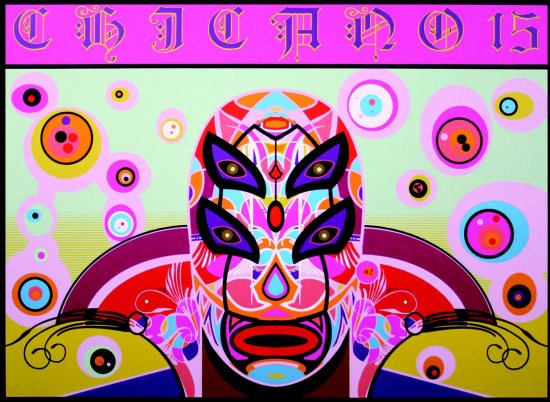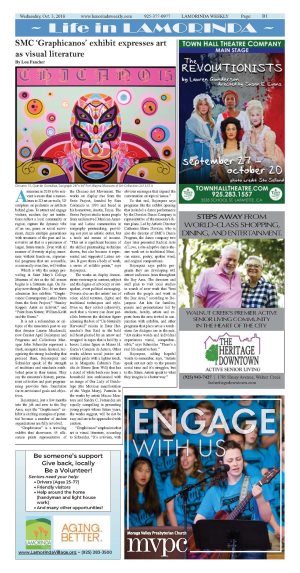| | Published Octobwer 3rd, 2018
| SMC 'Graphicanos' exhibit expresses art as visual literature
| | | By Lou Fancher |  | | Chicano 15, Quintin Gonz†lez, Serigraph 28" x 36" Fort Wayne Museum of Art Collection 2013.57.9 |
A museum in 2018 to be relevant is more than a mausoleum to 2D art on walls, 3D sculpture on pedestals or artifacts behind glass. To attract and engage visitors, modern day art institutions reflect a local community or region, capture the dynamic vibe of an era, genre or social movement, dazzle multiple generations with treasures of the past and innovative art that is a precursor of larger, future trends. Even with all manner of diversity at play, museums without hands-on, experiential programs that are accessible, occasionally even free, will wither.
 Which is why the energy prevailing at Saint Mary's College Museum of Art as the fall season begins is a fortunate sign. On display now through Dec. 16 are three admission free exhibits: "Graphicanos: Contemporary Latino Prints from the Serie Project;" "Stanley Koppel: Artist as Activist;" and "Paint from Nature; William Keith and the Sierra."
Which is why the energy prevailing at Saint Mary's College Museum of Art as the fall season begins is a fortunate sign. On display now through Dec. 16 are three admission free exhibits: "Graphicanos: Contemporary Latino Prints from the Serie Project;" "Stanley Koppel: Artist as Activist;" and "Paint from Nature; William Keith and the Sierra."
 It is not a referendum or critique of the museum's past to say that director Lauren Macdonald, new Curator April Bojorquez and Programs and Collections Manager John Schneider represent a fresh, energetic team. Instead, recognizing the strong leadership that proceed them, Bojourquez and Schneider speak of the strength of traditions and standards established prior to their tenure. They say the museum's history, permanent collection and past programming provides firm foundation for re-envisioned goals and objectives.
It is not a referendum or critique of the museum's past to say that director Lauren Macdonald, new Curator April Bojorquez and Programs and Collections Manager John Schneider represent a fresh, energetic team. Instead, recognizing the strong leadership that proceed them, Bojourquez and Schneider speak of the strength of traditions and standards established prior to their tenure. They say the museum's history, permanent collection and past programming provides firm foundation for re-envisioned goals and objectives.
 Bojourquez, just a few months into the job and new to the Bay Area, says the "Graphicanos" exhibit is exciting examples of potential because a number of student organizations are fully involved.
Bojourquez, just a few months into the job and new to the Bay Area, says the "Graphicanos" exhibit is exciting examples of potential because a number of student organizations are fully involved.
 "Graphicanos" is a traveling exhibit that showcases 45 silkscreen prints representative of the Chicano Art Movement. The works on display rise from the Serie Project, founded by Sam Coronado in 1993 and based in his hometown, Austin, Texas. The Series Project studio trains people from underserved Mexican American and Latino communities in serigraphy printmaking; providing not just an artistic outlet, but a trade and means of income. "This art is significant because of the skilled printmaking technique shown, but also because it represented and supported Latino artists. It gave them a body of work, a series of sellable prints," says Bojorquez.
"Graphicanos" is a traveling exhibit that showcases 45 silkscreen prints representative of the Chicano Art Movement. The works on display rise from the Serie Project, founded by Sam Coronado in 1993 and based in his hometown, Austin, Texas. The Series Project studio trains people from underserved Mexican American and Latino communities in serigraphy printmaking; providing not just an artistic outlet, but a trade and means of income. "This art is significant because of the skilled printmaking technique shown, but also because it represented and supported Latino artists. It gave them a body of work, a series of sellable prints," says Bojorquez.
 The works on display demonstrate vast range in content, subject and the degree of advocacy or outspoken, overt political messaging. Diverse also are the artists' use of color, added textures, digital and traditional techniques and style. Even so, they collect cohesively, such that a viewer can draw parallels between the skeleton figure adorning the box of "Un-Naturally Harvested" raisins in Ester Hernandez's Sun Raid to the bold red heart pierced by an arrow and wrapped in ropes that is held by a heroic Latino figure in Mauro H. Garza's Corazon de Azteca. Other works address social justice and cultural pride with a lighter touch, as in Margarita Cabrera's Plancha de Hierro (Iron Will) that has a cloud of white birds rise from a household iron emblazoned with an image of Our Lady of Guadalupe (the Mexican manifestation of the Virgin Mary). Portraits in the works by artists Maceo Montoya and Sandra C. Fernandez are equally compelling in presenting young people whose future years, the works suggest, will be not be easy and are to be approached with caution.
The works on display demonstrate vast range in content, subject and the degree of advocacy or outspoken, overt political messaging. Diverse also are the artists' use of color, added textures, digital and traditional techniques and style. Even so, they collect cohesively, such that a viewer can draw parallels between the skeleton figure adorning the box of "Un-Naturally Harvested" raisins in Ester Hernandez's Sun Raid to the bold red heart pierced by an arrow and wrapped in ropes that is held by a heroic Latino figure in Mauro H. Garza's Corazon de Azteca. Other works address social justice and cultural pride with a lighter touch, as in Margarita Cabrera's Plancha de Hierro (Iron Will) that has a cloud of white birds rise from a household iron emblazoned with an image of Our Lady of Guadalupe (the Mexican manifestation of the Virgin Mary). Portraits in the works by artists Maceo Montoya and Sandra C. Fernandez are equally compelling in presenting young people whose future years, the works suggest, will be not be easy and are to be approached with caution.
 "Graphicanos" emphasizes that art is visual literature, according to Schneider. "It's activism, with obvious messages that expand the conversation on topical issues."
"Graphicanos" emphasizes that art is visual literature, according to Schneider. "It's activism, with obvious messages that expand the conversation on topical issues."
 To that end, Bojorquez says programs like the exhibit opening that included a dance performance by the Davalos Dance Company is representative of the museum's future plans. Led by Artistic Director Catherine Marie Davalos, who is also the director of SMC's Dance Program, the dance company two days later presented Radical Acts of Love, a site-adaptive dance-theatre work set to traditional Mexican music, poetry, spoken word, and original compositions.
To that end, Bojorquez says programs like the exhibit opening that included a dance performance by the Davalos Dance Company is representative of the museum's future plans. Led by Artistic Director Catherine Marie Davalos, who is also the director of SMC's Dance Program, the dance company two days later presented Radical Acts of Love, a site-adaptive dance-theatre work set to traditional Mexican music, poetry, spoken word, and original compositions.
 Bojorquez says public programs they are developing will attract audiences from throughout the Bay Area. The directors and staff plan to visit local studios in search of new work that "best reflects the people and work in the Bay Area," according to Bojorquez. Art kits for families, panels and presentations led by students, faculty, artists and experts from the area invited in conjunction with exhibits, and other programs that place art as a touchstone for dialogue are in the mix. "Art makes words and individual experiences visual, comprehensible," says Schneider. "There's a real life narrative here."
Bojorquez says public programs they are developing will attract audiences from throughout the Bay Area. The directors and staff plan to visit local studios in search of new work that "best reflects the people and work in the Bay Area," according to Bojorquez. Art kits for families, panels and presentations led by students, faculty, artists and experts from the area invited in conjunction with exhibits, and other programs that place art as a touchstone for dialogue are in the mix. "Art makes words and individual experiences visual, comprehensible," says Schneider. "There's a real life narrative here."
 Bojorquez, adding hopeful words to remember, says, "Artists speak out not only to the present social time and it's struggles, but to the future. Artists speak to what they imagine is a better way."
Bojorquez, adding hopeful words to remember, says, "Artists speak out not only to the present social time and it's struggles, but to the future. Artists speak to what they imagine is a better way."


|
| | | | | | | | | | | | |



